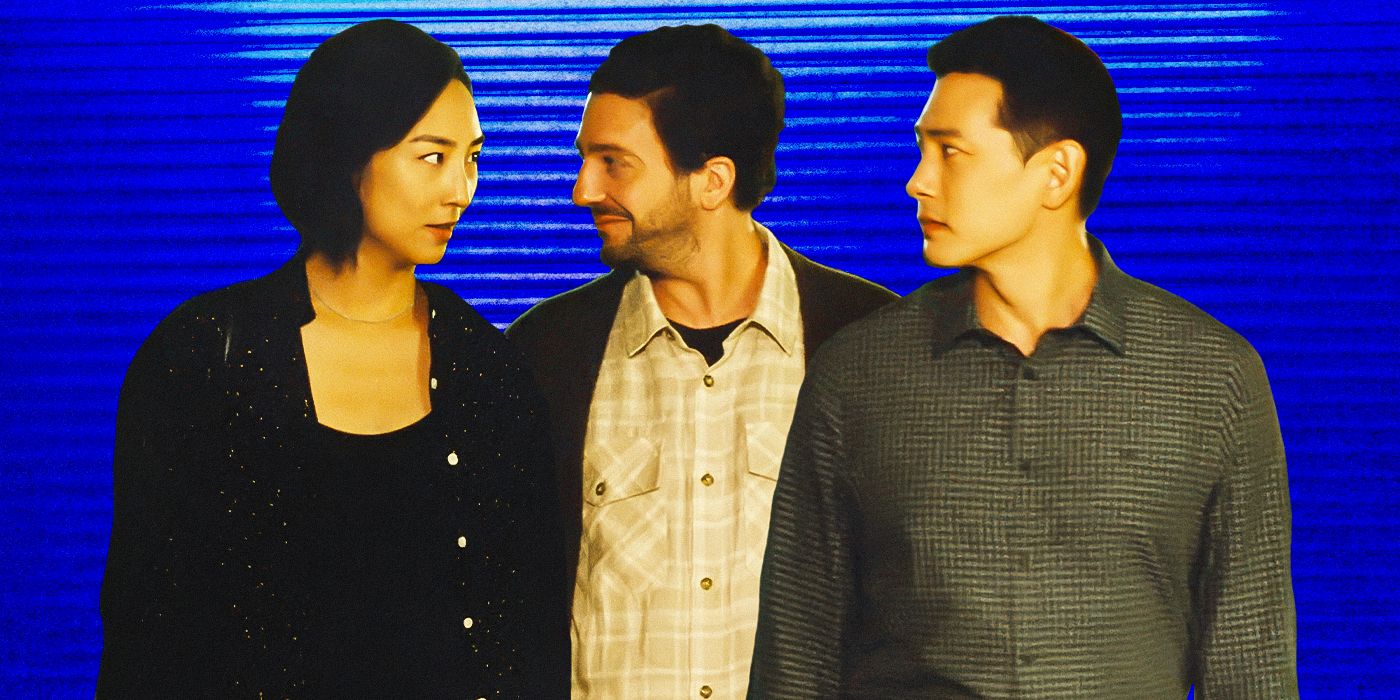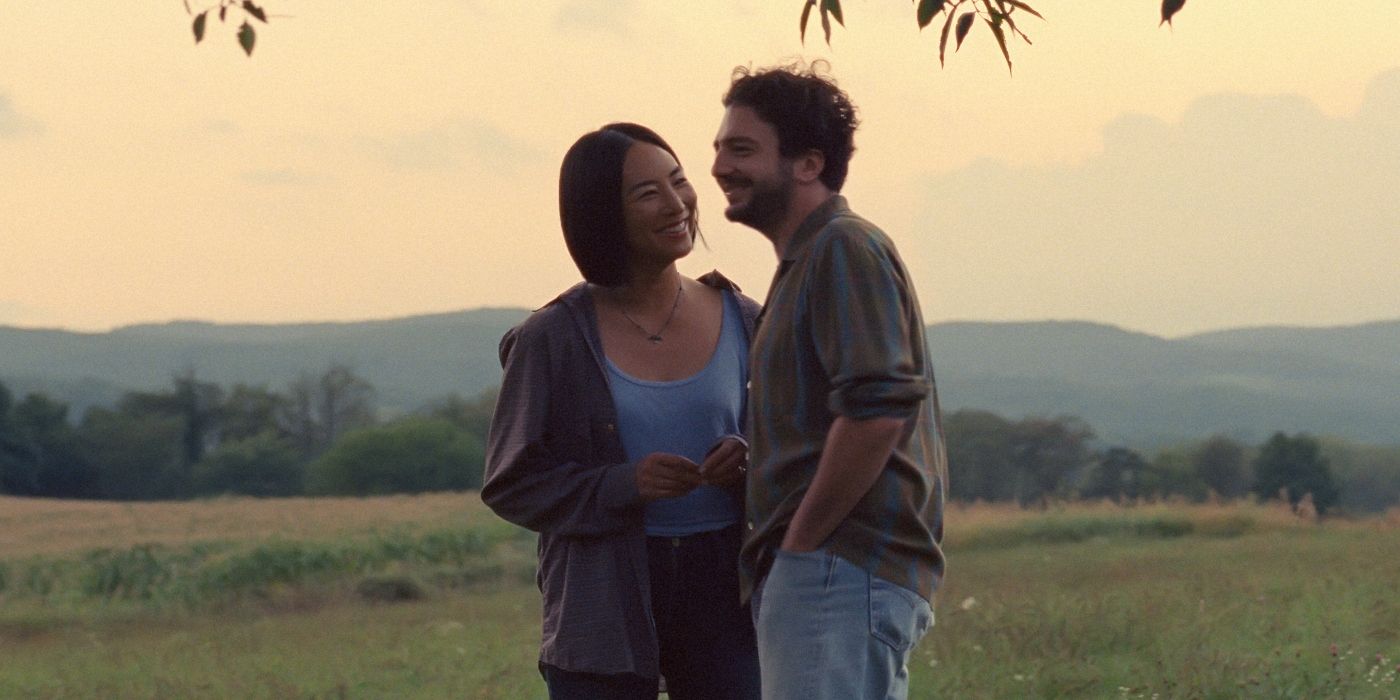The Big Picture
- Subtle physical gestures reveal deep emotions in
Past Lives
, making characters feel distinctly human. - Celine Song’s film challenges norms by focusing on tiny body language moments rather than grand gestures.
- Small details, like head tilts and subtle eye contact, convey rich internal worlds and enhance realism in
Past Lives
.
There’s a moment early in Past Lives where protagonist Nora (Greta Lee) is so excited about an impending Skype chat with childhood sweetheart Hae Sung (Teo Yoo) that we see her swing her left arm around and around up in the air. It’s her dominant gesture as she walks back to her apartment, a process captured in a wide shot emphasizing the larger bustling metropolis, New York City, Nora calls home. Even in this expansive shot, Nora’s swinging arm is emphasized. It’s a tiny piece of body language, something that would be a throwaway beat in other movies if it even made the final cut. Here in Past Lives, though, writer/director Celine Song embraces that instance of subtle physicality.
Throughout this movie, Song and the actors she’s assembled for this story demonstrate a gift for exuding tiny pieces of body language that speak volumes about Nora, Hae Sung, and Nora’s husband, Arthur (John Magaro). The beauty of the A24-distributed feature Past Lives comes from its understanding of how the smallest interactions or conversations can linger with us for a lifetime. It’s only appropriate that the performances anchoring that movie would thrive on small pieces of physicality that just make everyone in Past Lives feel so distinctly human.
Past Lives
Nora and Hae Sung, two deeply connected childhood friends, are wrested apart after Nora’s family emigrates from South Korea. Twenty years later, they are reunited for one fateful week as they confront notions of love and destiny.
- Release Date
- June 23, 2023
- Director
- Celine Song
- Runtime
- 106 minutes
- Writers
- Celine Song
Big Romantic Dramas Typically Go Big and Over-the-Top
The standards for romantic dramas in cinema, throughout history, have been to go big or go home. The most iconic entries in this genre have been dominated by images of couples smooching on the beach as the tide washes over their bodies or the grand declaration of “Frankly my dear, I don’t give a damn” signaling the end of a relationship with all the vivid force of a gun being fired. This approach has proven so popular that it’s been carried over into the modern world, with projects like The Notebook concluding on their main characters giving out passionate speeches about love in the pouring rain.
Grand cinematic reflections of love are not innately a bad or shallow thing. On the contrary, some of the greatest romantic dramas in history have been deeply externalized portrayals of human beings attracted to one another. F.W. Murnau’s 1927 masterpiece Sunrise: A Song of Two Humans is one of the greatest movies ever made, romantic drama or otherwise, and it throws subtlety to the wind with its bombastic visuals. Even title cards like, “Couldn’t she get drowned?” are given such maximalist life informed by the vibrant urges of the on-screen characters. It’s a masterclass in how pronounced visuals and performances can command rich levels of pathos.
However, such portrayals of romantic yearning are not the only ways to explore those emotions on the big screen. A more subdued way to capture romance on the big screen is with more observational, atmospheric movies that let a connection between two souls gradually simmer on the big screen. The likes of Richard Linklater,Wong Kar-Wai, and Barry Jenkins have proven to be masters of this approach, in the process subverting the idea of what romantic-drama movies can look like. Celine Song’s work in Past Livesfollows in the footsteps of these filmmakers while also blazing a new identity that solely belongs to her.
The Little Impactful Moments of ‘Past Lives’
In Past Lives, the first meeting of Nora and her future husband Arthur is quite incidental. They’re both staying at the same writer’s retreat. The two end up bonding while chatting with a group of writers at night, with the two eventually talking on their own long into the night. At the end of this conversation, Nora references the Korean concept of “in-yeon” to Arthur as “something Koreans say when they’re trying to seduce someone.” After this, there’s silence, with Song’s camera lingering on the two in the darkness illuminated only by a string of overhead lights.
Here, the subtle physicality of Past Lives beautifully bubbles to the surface. Both Arthur and Nora engage in a series of slight head turns and leans that indicate that Nora’s word choice there wasn’t accidental. She’s trying to seduce Arthur. No concrete words need to be exchanged. Slight head movements capture a blossoming romance. This particular instance of subdued physicality embodies how Past Lives uses the tiniest pieces of physical human behavior to convey rich internal worlds. Their quiet pieces of body language enhance the realism of Past Lives and lend insight into whom these fictional people are.
That earlier Nora and Arthur scene doesn’t just encapsulate the masterful subtle physicality that makes Past Lives so great, though. It also makes for an effective contrast to a subsequent important scene taking place more than a decade later. Here, Nora and Hae Sung reunite in person for the first time in over 20 years. It’s a momentous occasion peppered with tiny pieces of realistic awkwardness. A hug between the two, for instance, seems to be ending only for Hae Sung to slightly prolong it. Afterward, as the two begin to walk together, eye contact between the two characters is erratic. There isn’t hostility in Nora and Hae Sung’s rapport. They’re just so overwhelmed by this reunion that they can’t maintain constant eye contact. Nora and Arthur’s nighttime conversation was defined by intimate physicality suggesting a union between two souls. The physicality in this Nora and Hae Sung reunion, meanwhile, quietly communicates two old friends who seem like strangers to one another.
The complicated precise physicality between Nora and Hae Sung in their initial reunion sequences provides some of the best examples of the subtle body language that makes Past Lives so compelling. A moment where the pair are just sitting in front of a carousel silently, occasionally looking up to grab glances at one another, is especially moving in this regard. Decades of the other person’s existence remain a mystery they can barely comprehend. The figures before them are so staggering that they can only grab brief glimpses of each other. Eventually, Nora restarts the conversation between herself and Hae Sung, but you don’t need dialogue to understand the underlying tension between these characters thanks to the rich body language on display.
‘Past Lives’ Devil Is in the Details
The night after Nora and Hae Sung spend the afternoon together in New York City, Arthur is contemplating all the potential ramifications of this reunion and what it means for his marriage. It’s easy to imagine how a typical modern romantic drama, even one done on an indie movie budget, would proceed to depict his complicated emotions. A lesser film would have to indulge in an obvious showy display of martial turmoil that then gets disposed of as quickly as it arrived in the screenplay. Thankfully, Celine Song once again reaches for more innovative means of communicating a character’s feelings.
The subtle physicality of Past Lives is displayed once again in one of its most moving scenes, in which Arthur and Nora share an extended conversation about their relationship in the dead of night. Because they’re in bed, the duo can’t move around much, which is the point. Here they’re forced to confront one another’s worries, dreams, and personalities. John Magaro’s quiet dialogue deliveries as Arthur (“You open up my world so much…I hope I do the same for you.”) are utterly devastating in such intentionally restrictive confines. Most importantly, he and Greta Lee both show impressive skill in lending intent and pathos to what little movement these two characters do exhibit. Every brief glimpse of a smile, shift in bed, or adjustment of a person’s head speaks so much to the universe of emotions Nora and Arthur are both navigating.
Within these intimate spaces, Song is imploring the viewer to truly pay attention to every movement Nora and Arthur make, not to mention the underlying intent of their actions. Throughout Past Lives, Song finds similarly constrictive backdrops that force both these fictional characters to interact and for viewers to be especially conscious of all subtly meaningful on-screen body language. The entire movie begins in media res with all three lead characters in a tiny New York bar, for instance, with the camera zooming on Nora’s seemingly static but subtly illuminating facial expression. Meanwhile, Nora and Hae Sung spend time together in environments like a cramped subway car and a ferry. These are incredibly reliable places for human beings to connect. They’re also wisely chosen backdrops in how their innately intimate aesthetic force so much attention (without undercutting the naturalism of the filmmaking) onto Nora, Hae Sung, and Arthur’s smallest physical expressions of internal yearning.

The 10 Best Directorial Debuts of 2023, Ranked by Letterboxd
Don’t underestimate the newbies.
The Little Details in ‘Past Lives’ Make All the Difference
Human beings get stuck on the tiniest things, both in ourselves and other people. It’s a universal phenomenon that Past Lives leans on so skillfully in its incredibly idiosyncratic narrative. Celine Song’s filmmaking and direction of actions in Past Lives emphasizes how tiny pieces of physicality can be something that gets to the very pit of our soul. An extended shot capturing Hae Sung learning from Nora (when they’re both 24 years old) that she wants to cut off their recurring Skype chats, for instance, only consists of a closer shot of Hae Sung’s face. His expression doesn’t change very much as he tries to put on a stiff upper lip about the whole affair, with the unbroken nature of this close-up shot reflecting how Hae Sung wants to be consistently chill in responding to this news. However, Teo Yoo magnificently uses slight head tilts and a sense of devastation in his eyes to convey how this character truly feels.
The quietly revealing details in Teo Yoo’s performance reflect how often people say so much in small terms. Many modern romantic dramas forget this. They fail to channel the impeccably realized maximalism of works like Sunrise: A Song of Two Humans, instead opting for didactic representations of yearning and heartache. In addition to being a masterpiece on its own terms, Past Lives is a balm to modern projects that only recognize romantic emotions through predictable melodramatic terms like unexpected bus crash deaths.
Celine Song’s writing and direction, not to mention the trio of unforgettable lead performances, opt for a much smarter approach. These creative qualities all realize how much power is communicated in just the arrangement of characters in a frame or the kind of eye contact two people share. The smallest pieces of physicality from ourselves and others are often something we can never forget. That kind of body language is rendered similarly indelible within the deeply moving world of Past Lives.
Past Lives is streaming on Showtime in the U.S.
Watch on Showtime





